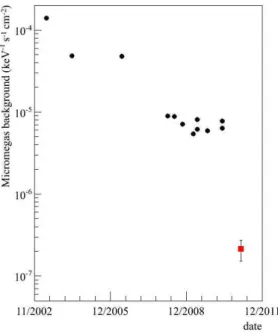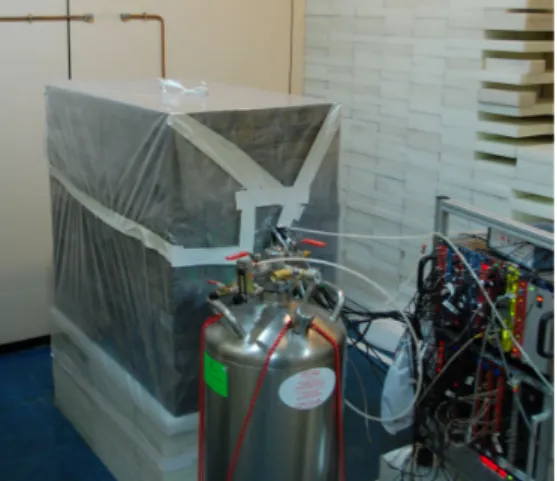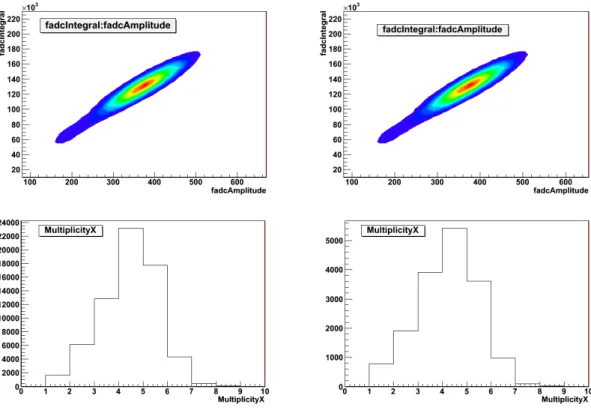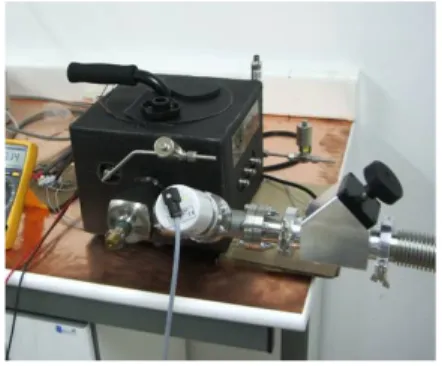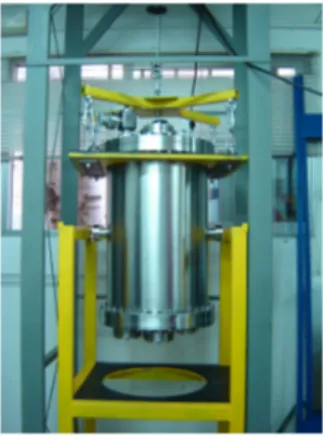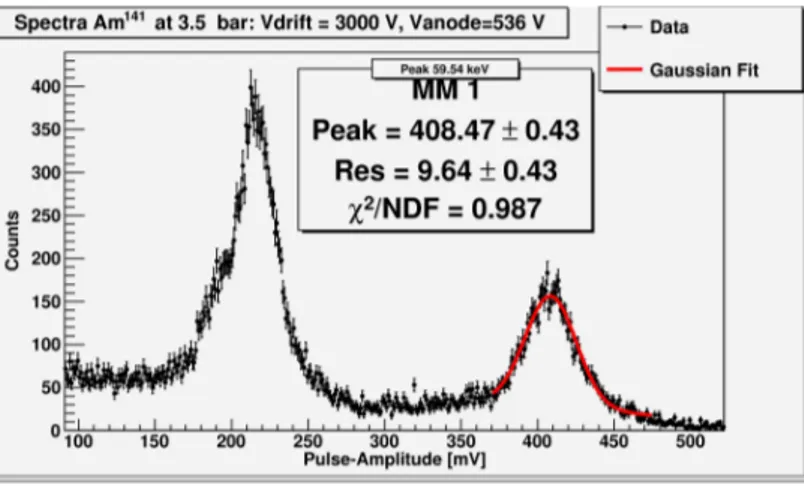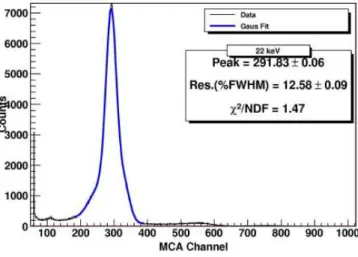This content has been downloaded from IOPscience. Please scroll down to see the full text.
Download details:
IP Address: 212.174.144.130
This content was downloaded on 16/12/2015 at 14:22
Please note that terms and conditions apply.
The T-REX project: Micromegas for Rare Event Searches
View the table of contents for this issue, or go to the journal homepage for more 2012 J. Phys.: Conf. Ser. 347 012030
The T-REX project: Micromegas for Rare Event
Searches
T Dafni1, S Aune2, J Castel1, S Cebri´an1, G Fanourakis3,
E Ferrer-Ribas2, D Fortu˜no1, J Gal´an2, J A Garc´ıa1, A Gardikiotis4, J G Garza1, T Geralis3, I Giomataris2, H G´omez1, D C Herrera1, F J Iguaz2, I G Irastorza1, G Luz´on1, J P Mols2, A Ortiz1,
T Papaevangelou2, A Rodr´ıguez1, J Ruz5, L Segui1, A Tom´as1, T Vafeiadis6,5,4 and S C Yildiz7,8
1
Grupo de F´ısica Nuclear y Astropart´ıculas, University of Zaragoza, Zaragoza, Spain
2 IRFU, Centre d’ ´Etudes de Saclay, CEA, Gif-sur-Yvette, France 3
Institute of Nuclear Physics, NCSR Demokritos, Athens, Greece
4 University of Patras, Patras, Greece 5
CERN, European Organization for Particle Physics and Nuclear Research, Switzerland
6 Aristotle University of Thessaloniki, Thessaloniki, Greece 7
Bo˘gazi¸ci University, Istanbul, Turkey
8
Do˘gu¸s University, Istanbul, Turkey E-mail: tdafni@unizar.es
Abstract. The T-REX project aims at developing novel readout techniques for Time Projection Chambers for experiments searching for Rare Events. The Micromegas detectors are a good option, because of their good performance regarding low background levels, energy and time resolution, gain and stability of operation. In the present we will shortly refer to two particular cases, on one hand their performance in the CAST experiment and on the other the studies carried out within NEXT, a neutrinoless double-beta decay experiment.
1. The T-REX project
The field of Rare Event Searches is composed of searches involving processes with very low expected rates like the axion, dark matter or the neutrinoless double-beta decay (0νββ). It is exactly because of the low expected rates that these searches dictate challenging experimental requirements, the main one being to bring down the experimental backgrounds to the lowest levels possible. The ultra-low background techniques to achieve this include the use of active and passive shielding, operation in underground sites, event discrimination and a careful selection of the detector materials from the radiopurity point of view.
It is only lately that the gaseous time projection chambers (TPC) are being seriously considered as options for the Rare Event Searches, despite the fact that they could offer unique features to their detection. One of them is the topological information, and therefore the directionality of an event, that gas TPC can provide allowing a powerful tool to discriminate signal events from background ones. The complexity rose mainly because of the large volumes and long exposures necessary and all the complications that might arise from that in terms of mechanics, electronics and operation of the chamber itself mainly of the detector readout used.
This change has been produced mainly because of the latest developments on TPC readouts, the micropattern gas detectors (MPGD), that are overcoming the limitations of the previous generations. The technological boost provided by these readouts has been the use of metallic strips or pads, precisely printed on plastic supports with photolithography techniques, substituting the traditional wires of the previous generation of detectors. The simplicity, robustness and mechanical precision are much higher than those of conventional planes of wires. One of the most attractive MPGD for application in Rare Events, is the Micromegas readout plane[1]. The Micromegas detectors have attracted a lot of attention since their invention in 1996, for their potential use in this field of particle physics, among others. Since then it has been constantly and substantially improved, especially regarding the manufacturing techniques. The T-REX project proposes to merge the latest gas TPC readout concepts and the ultra-low background techniques know-how in order to develop practical ideas that could be used in the field of Rare Event Searches. The main component of these studies is the use of the latest generation Micromegas microbulk readout planes and their further development in order to meet the rather strict requirements of these searches. We give examples in the frame of two different applications, within the CAST experiment [2, 3, 4, 5] for axion searches and within the NEXT project [6, 7] for the neutrinoless double beta decay.
Micromegas technologies The Micromegas readouts are composed of a metallic micromesh suspended over an anode plane by means of isolator pillars, thus defining an amplification gap of the order of 50–150 µm. Electrons drifting towards the readout, go through the micromesh holes and trigger an avalanche inside the gap, inducing detectable signals both in the anode pixels and in the mesh. This amplification geometry has advantages that are of special interest in the context of Rare Events, like good energy resolution and a very low dependance of gain on geometrical or environmental factors, which have been important drawbacks of the previous generation of gas detectors.
The classic Micromegas design [1] has been used in several applications, including nuclear physics experiments at CERN, medical applications, etc. In the last years a lot of effort has been invested to improve the detectors’ performance starting with its construction technique. These efforts have resulted in two new types of detectors, build with the bulk [8] and microbulk [9] technologies. The improvement they presented, is that the mesh is no longer suspended above the anode mechanically, instead it is united with the active area by gluing the two parts, as is the case of the bulk, or built together with the active area during the construction process, as is the case of the microbulk. In this way, they provide better robustness, uniformity and therefore stability of operation.
Detectors of both types were constructed and tested in the lab, before they were installed in the CAST experiment, achieving very good background rejection factors.
2. Micromegas for Solar axions
The CAST (CERN Axion Solar Telescope) experiment is searching for axions. The energy range of the expected signal is between 1 and 10 keV and therefore low background detectors are necessary for the experiments sensitivity. The experiment is counting with a powerful dipole magnet and and x-ray focusing device, both of which make CAST the most sensitive helioscope so far.
However, the possibility to improve the key characteristics of a helioscope, with respect to CAST, has lead to a study of the New Generation Axion Helioscope (NGAH) [10]. These characteristics, include the magnetic field volume, the use of x-ray focusing optics and, of most interest for the present work, detector backgrounds. The new helioscope will improve the sensitivity of the technique by 1-1.5 orders of magnitude, enabling it to probe a large range
of axion models. Within the scope of the NGAH, the developments described in the present work are further motivated.
Micromegas detectors have been taking data since the beginning of the experiment in 2003. CAST has been a test ground for these detectors, where they have been combined with low background techniques like the use of shielding, radiopurity screening of detector components or advanced event discrimination techniques.
All three types of Micromegas have been used in the experiment through the years. The CAST Micromegas have typically an amplification gap of 50 µm, hole diameters of 30 µm and a pitch of 550 µm and a total active area of 36 cm2. They were the first to be constructed with a 2d readout, where the anode consists of square pads interconnected in the diagonal direction through vias. Since the upgrade in 2007, the number of Micromegas installed in the experiment was increased from one to three, being now all three of them of the microbulk type. During the upgrade there were improvements in the shielding of all detectors, which in combination with the better characteristics of the microbulks, has lead to an improvement of the detector performance. The effect on the background levels can be appreciated in the plot of Figure 1: they have dropped by at least a factor of 20, with the current detectors showing levels of 6–9×10−6s−1cm−2keV−1.
Figure 1. A history of the background levels of the Micromegas detectors registered in different periods of data taking in the CAST experiment. The effect of the different technologies and shielding can be appreciated, as the background levels have improved by at least a factor of 20 with respect to the first detectors. The last point on the right represents the background level recorded in the LSC when the detector was covered with 20 cm of lead. This level is approx. 20 times lower than the standard levels registered in the CAST experiment.
2.1. Studies underground
The experience gathered within CAST and the good performance of the detector, encouraged more dedicated studies for the full understanding of the background levels observed with the aim to push these at the minimum.
On one hand, part of the efforts are focused on experimental background measurements in an environment with well controlled parameters, in order to systematically explore the diverse parameters and configurations in search for a correlation with backgrounds levels. To begin with, a copy of one of the systems in CAST showing very low background levels was prepared and installed to take data in the lab in Zaragoza. The setup is housed inside a Faraday cage,
with an inner shielding of copper and lead, an outer shielding of polyethylene and it has been completed with a nitrogen flux in the vicinity of the chamber, imitating the setup of the CAST detectors (Figures 2 and 3).
Figure 2. A photo of the setup in the Zaragoza lab, where the detector can be seen mounted inside the copper and lead shielding and the electronics housed in a Faraday cage.
Figure 3. The same setup in the Zaragoza lab shown in Figure 2, with the Faraday cage surrounded by the polyethylene shielding.
After a short period of data-taking, the system was moved underground, in the Canfranc Underground Laboratory (LSC) in the Spanish Pyrenees. There are several advantages in working underground; among them, the fact that the flux of the cosmic muons is greatly reduced (a factor 104), that the environmental conditions like humidity, temperature and pressure are stable, and most importantly, that the flux of gammas in the laboratory is well known. An additional advantage is that the amount of external shielding (lead, primarily) can be largely varied and its effects studied, something that could not take place in the experiment itself because of space and weight restrictions. A continuous Nitrogen flux is provided to purge the radon that could stay close to the detector (Figure 4). With these parameters under control, important conclusions can be drawn for the contribution of the individual background sources (cosmics, external gammas, internal background from contamination) as well as possible systematic effects that could be related with the environmental conditions.
Figure 4. A photo of the setup in the Canfranc Underground laboratory: The Faraday cage that houses the detector is placed inside a lead shielding, here covered in 4π. The dewar placed in front of the shielding provides the Nitrogen flux.
The studies are still ongoing, but levels as low as 2×10−7s−1cm−2keV−1 are reached by adding more lead all around the detector (Figure 1). This level corresponds to the intrinsic level of the radiopurity of the detector components. The results obtained, indicate that the
background at CAST is most probably driven by the external gamma radiation. These studies provide the needed information in order to design improvements on the shielding of some of the detectors in CAST. Another conclusion, which will be commented in a later section, is that the levels of radioactivity in these detectors (and the surrounding materials) are very low. Furthermore, all the information obtained by these studies, can be used to devise the design of the future helioscope.
The second branch of the work was focused on a general and complete simulation of the detector. Based on Geant4, simulations have been prepared with a detailed description of the geometry of the detector and its shielding. Special care has been taken to include information about radiopurity measurements that have been performed at the LSC, using the materials that compose the detector. A big effort was invested in implementing all the ingredients from signal generation to the response of the electronic chain as is currently used in CAST. The first results show that the simulation seems to describe successfully the system. As an example, Figure 5 shows the comparison of two parameters of the detector signal as given by the experiment (left column) and the simulation (right column) for a calibration run where an 55Fe source is used.
Figure 5. Comparison of two parameters of the detector performance as observed in the experiment (left column) and by the simulation (right column). At the top is seen the integral versus the amplitude of the pulse signal collected in the mesh, while at the bottom the number of consecutive strips or pads activated in an X-ray event, also know as multiplicity of the event.
More details on this work can be found in [11, 12, 13, 14]. 3. Studies within the NEXT project
The neutrinoless double-beta decay experiments are another part of the Rare Event Searches where Micromegas readouts could be used. NEXT (Neutrino Experiment with a Xenon TPC) is one of these experiments. It is a project approved by the LSC in the Spanish Pyrenees. It
has been funded by the Consolider Program of the Spanish Ministry of Science to carry out the construction of a 100 kg enriched high-pressure xenon gas (HPGXe) TPC. The proposal has good prospects regarding the requirements of such an experiment: the excellent energy resolution which can be achieved, the background rejection power provided by the topological information of the electron tracks, the ability to define a t0 (thus a fiducial region away from any surface), and the scaling-up to large masses. The final detector, NEXT-100, will hold 100 kg of Xe gas enriched in 136Xe, its ββ-decaying isotope. The project baseline is to build the TPC based on the electroluminescence technique using a Photomultiplier tubes (PMT) plane for the energy measurement and SiPMs for the topological information [15]. Another option that was studied was using APDs[16], while here we will discuss the option of the charge collection with Micromegas [17], studied within the T-REX project.
As mentioned before, the requirements that the readout planes should meet regard operation at high pressure, good energy resolution, low radioactivity. The primary goal of the first tests were to establish that the Micromegas planes can operate satisfactorily in high pressure pure Xenon. As a second step, to explore their energy resolution performance, whether it can reach the levels required for a neutrinoless double beta decay search with Xe.
Two prototypes were built to test the performance of Micromegas readouts at high pressure in pure Xe. The first one, known as NEXT-0-MM, is a Stainless Steel vessel of 2 litres, with a diameter of approx. 14 cm and a drift region of 6 cm. In the interior a series of 6 copper rings interconnected with resistors form a field cage. The cathode consists of a copper disk with a hole to accommodate the sources used in the tests (Figures 6, 7).
Figure 6. A photo of NEXT-0-MM. The vessel is covered with an insulator layer (black).
Figure 7. The field cage of NEXT-0-MM: six copper rings interconnected via resistors, held in place by three PEEK bars and a copper disk as a cathode on top.
While this was testing Micromegas detectors at high pressures, a second prototype was designed and built with the aim to study electron tracks, which would be the expected signal. These would reach a length of the order of 30 cm in a 10 bar Xe environment. Therefore, NEXT-1-MM, has an inner volume of approximately 75 litres, measuring 600 mm of height and almost 400 mm in diameter (Figure 8). The vessel should hold 1 kg of Xenon at a pressure of 10 bar. This vessel, like the smaller prototype, is also equipped with a field cage which defines a drift length of 35 cm. The structures is composed of 34 copper rings, interconnected with 10 MΩ resistors, which can be seen in Figure 9.
The Micromegas readouts used in the tests were of the microbulk type and they were mainly circular readouts with an amplification gap of 50 µm and 35 mm diameter whose anode was not segmented (Figure 10). When the manufacturing technology permitted bigger areas, tests were made with a readout with an active area of 10×10 cm2 (Figure 11). This has a pixelized anode
Figure 8. A photo of the NEXT-1-MM prototype and its supporting structure.
Figure 9. The field cage of NEXT-1-MM: 34 copper rings, connected through resistors and held by PEEK bars.
with a total of 144 pixels. However, bigger readouts were needed to equip NEXT-1-MM, which has an active area corresponding to a diameter of 30 cm. The first readout prepared for that vessel was a circular bulk detector, seen in Figure 12, with a segmented anode of 1252 pixels. Lately a microbulk detector with a side of 15 cm was manufactured (Figure 13). It has a shape of a quarter of a circle, such as that we need four of these to cover the active area of NEXT-1-MM. Each of the sectors counts 288 pixels. During the tests both signals of the anode and of the mesh are recorded.
Figure 10. The first generation of microbulk Micromegas used. They had a diameter of 35 mm and an amplification gap of 50 µm.
Figure 11. The first large microbulk built, with a segmented anode. It has an active area of 10×10 cm2 divided into 144 pixels.
Examples of tracks In the cases where the Micromegas readouts have a segmented anode, the pixels are individually read. This is done employing the electronics used in the T2K experiment. To read the first ever pixelized microbulk Micromegas, a reduced version of the electonics was connected to 72 out of the 144 pixels. An example of a track can be seen in Figure 14. In NEXT-1-MM, the bulk installed had 1252 pixels and therefore the full chain of the T2K electronics was necessary to record tracks like the one in Figure 15.
Figure 12. A photo of the bulk Micromegas detector installed in the NEXT-1-MM. It has a diameter of 30 cm and its anode is segmented to ∼1200 pixels.
Figure 13. A photo of the new microb-ulk Micromegas recently constructed. It is one of the four sectors that will be in-stalled in order to cover the sensitive sur-face of NEXT-1-MM.
Figure 14. Projection of an alpha track obtained with the241Am source in NEXT-0-MM. A reduced version of the T2K electronics was used to read the pixels. On the right is the 2D mapping of the event while on the left, a 3D reconstruction of the same event.
Figure 15. An alpha track of approximately 4 cm obtained with the222Rn source in
NEXT-1-MM. The shaded area corresponds to the active surface of the bulk detector.
Studies at high pressure with various gases In order to determine the absolute position of an event along the drift direction, a measurements of the absolute time of interaction, or t0, is
needed. This can be obtained by the primary scintillation of Xe, that is why operation in pure Xenon would be required. The first tests performed were oriented towards this goal.
Different types of tests were performed with microbulk Micromegas readouts in NEXT-0-MM. The starting point of all microbulk measurements is testing them in Argon-iC4H10 mixtures.
Later, data in pure Argon and in pure Xenon were taken. All these measurements were repeated in various pressure settings, reaching 10 bar. In most of the cases the 241Am was used as a source, which emits alphas at an energy of 5.5 MeV. In others, gamma sources of low energy were employed. Here we will summarize the best results obtained.
In Ar-2%iC4H10 gas mixture, the best energy resolution achieved was 0.7% (FWHM) for the
with pure Ar and Xe, a protocol of purifying the system with long bake-out periods and warm Nitrogen circulation was followed. As seen in Figures 16 and 17, the best results achieved respectively, for the 5.5 MeV α of the 241Am, were 2.03% (FWHM) at 8 bar of Ar and 1.94% (FWHM) at 4 bar of Xe. Data with the pure Xe were taken as well at pressures of up to 8 bar, although the results are not so good due to attachment in the gas.
Figure 16. Energy spectrum of the
241Am 5.5 MeV alpha peak measured at
8 bar of pure Argon, showing an energy resolution of 2.03% FWHM.
Figure 17. Energy spectrum of the
241Am 5.5 MeV alpha peak measured at
4 bar of pure Xenon, showing an energy resolution of 1.94% FWHM.
Interesting results were also obtained when using the241Am source but blocking the alphas, thus probing lower energy region with the 59.54 keV photons that are also emitted. The few measurements at high pressure in these conditions, have yielded an energy resolution of 7.8% at 2 bar and 9.3% (FWHM) for the 60 keV γ of the241Am at 3.5 bar (Figure 18). Other colleagues in a smaller setup obtained more results in high pressures [19].
Figure 18. Energy spectrum of 59.54 keV γ in pure Xenon at 3.5 bar with an energy resolution of 9.6% (FWHM). The peak on the left is composed mainly of escape peaks from the 60 keV α, due to the fluorescence of Xe at 30 and 33 keV and partly of the 26 keV γ line of 241Am.
Although the first inclination was to work in pure Xe, the possibility of using a quencher gas is still very interesting. An extensive campaign of tests with other gas mixtures is ongoing. As an example, studies are being done with Xe-Ne mixtures, and Xe-TMA, with which higher gains
than in pure Xe have been achieved. In the case of Xe-TMA, very good energy resolutions seem to be at hand. Figure 19 shows an example of a measurement with a 109Cd source in Xe-2.4% TMA at 4 bar with an energy resolution better than 13% (FWHM) for the 22 keV photons. More results on these studies will soon be published.
Figure 19. Energy spectrum of the109Cd 22 keV gamma peak measured at 4 bar of a mixture of Xenon with 2.4%TMA. The energy resolution achieved is 12.6% FWHM.
Commissioning NEXT-1-MM Work in the bigger prototype is progressing slowly. There are currently two microbulks installed and being tested with alpha sources. The next steps include installing the four readouts in order to cover the complete active area and start the tests towards the goal of seeing electron tracks in the system.
4. Radiopurity of Micromegas planes
As mentioned before, in the field of Rare-Event searches the detectors, apart from other performance characteristics, are required to follow a strict budget on radiopurity; looking for the lowest background possible, a limiting factor could be the readout plane introduced. We performed the first measurements of the radiopurity of microbulk Micromegas planes in the low background facilities of the LSC with a high purity germanium detector [20]. The results obtained show radioactivity levels below 30 µBq/cm2 for Th and U chains and ∼60µBq/cm2 for
40K. These results are comparable to the cleanest detector components of the most stringent
low background experiments at present, despite the fact that the readouts measured were manufactured without any special care from the radiopurity point of view. Therefore it is reasonable to believe that after a dedicated study and development, these results will be improved.
Currently there is an effort to identify the most radioactive raw materials or the fabrication processes which may introduce radioactive traces during the construction of the planes and try to use alternative ones, aiming at even better results.
5. Conclusion
The aim of the T-REX project is to develop microbulk Micromegas readouts suitable for Rare Event Searches, taking advantage of ultra-low background techniques. A good part of this work has been done within the frame of two Rare Event Searches, Solar axions and NEXT.
The results of the studies show that the microbulk Micromegas are of most interest summing performance characteristics such as: stability of operation, very low background levels (6– 9×10−5s−1cm−2keV−1), good operation at high pressures and with very encouraging results regarding the energy resolution (1.96% (FWHM) at 4 bar of pure Xe for 5.5 MeV alphas, 9.5% (FWHM) at 3.5 bar of pure Xe for 60 keV gammas, 2.4%(FWHM) at 3.4 bar of Xe-2.4%TMA for 22 kev gammas). Moreover, the microbulk readouts show rather low radioactivity levels, a must for any readout plane to be used in such experiments.
Acknowledgments
We want to thank our colleagues of the groups of the University of Zaragoza, CEA/Saclay and our colleagues from the CAST, NEXT and RD-51 collaborations for helpful discussions and encouragement. We thank R. de Oliveira and his team at CERN for the manufacturing of the microbulk readouts. We acknowledge support from the European Commission under the European Research Council T-REX Starting Grant ref. ERC-2009-StG-240054 of the IDEAS program of the 7th EU Framework Program. We also acknowledge support from the Spanish Ministry of Science and Innovation (MICINN) under contract ref. FPA2008-03456, as well as under the CUP project ref. CSD2008-00037 and the CPAN project ref. CSD2007-00042 from the Consolider-Ingenio 2010 program of the MICINN. Part of these grants are funded by the European Regional Development Fund (ERDF/FEDER). Finally, we acknowledge support from the Regional Government of Arag´on under contract PI001/08.
References
[1] Giomataris Y, Rebougeard P, Robert JP and Charpak G, 1996 Nucl. Instr. and Meth. A 376 29 [2] Zioutas K et al. 1999 Nucl. Instrum. Meth. A 425, 480.
[3] Zioutas K et al. (CAST Collaboration),2005 Phys. Rev. Lett. 94 121301
[4] Adriamonje S et al (CAST Collaboration), 2007 J. Cosmol. Astropart. Phys. JCAP04(2007)01 [5] See talk on “CAST physics achievements and perspectives” by K. Zioutas et al. of this conference.
[6] Granena F et al. (The NEXT Collaboration) 2009 NEXT, a HPGXe TPC for neutrinoless double beta decay searches Preprint hep-ex/0907.4054
[7] Alvarez A et al. (The NEXT Collaboration) 2011 The NEXT-100 experiment for neutrinoless double beta decay searches (Conceptual Design Report) Preprint arXiv:1106.3630v1 [physics.ins-det]
[8] Giomataris Y et al., 2006 Nucl. Instrum. Meth. A 560 405–8 [9] Andriamonje S et al. 2010 J. Instrum. JINST 5 P02001
[10] Irastorza I G et al. 2011 J. Cosmol. Astropart. Phys. JCAP06(2011)013
[11] See talk on “CAST Micromegas detector performance” by S.C. Yildiz et al. of this conference.
[12] See talk on “CAST Micromegas detectors in the Canfranc Underground Laboratory” by A. Tom´as, TIPP 2011
http://indico.cern.ch/getFile.py/access?contribId=139&sessionId=16&resId=0&materialId=slides&confId=102998 [13] Gal´an J et al. 2010 J. Instrum. JINST 5 P01009
[14] Dafni T et al. 2011 Nucl. Instr. and Meth. A 628 172–6
[15] Liubarsky I for the NEXT Collaboration 2010 2011 J. Phys.: Conf Series 309 012007 [16] Lux T et al. 2010 2011 J. Phys.: Conf Series 309 012008
[17] Cebri´an S et al. 2010 J. Cosmol. Astropart. Phys. JCAP10(2010)010
[18] Dafni T, Ferrer-Ribas E, Giomataris I, Gorodetzky P, Iguaz F, Irastorza IG, Salin P and Tom´as A, 2009 Nucl. Instr. and Meth. A 608 259–66
[19] Balan C, Freitas EDC, Papaevangelou T, Giomataris I, Natal da Luz H, Monteiro CMB and dos Santos JMF, 2011 J. Instrum. JINST 6 P02006
